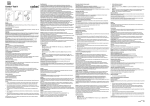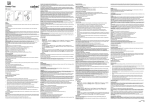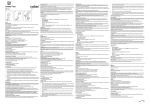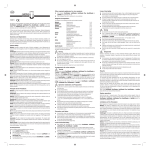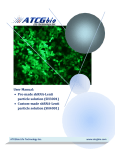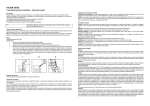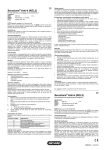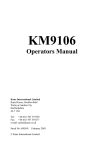Download Combur⁹ Test
Transcript
Do not use the test strip after the specified expiration date. Tightly re‑cap the container immediately after removing a test strip. Combur⁹ Test 04510038 191 50 04510046 040 100 Specimen collection and preparation For specimen collection and preparation only use suitable tubes or collection containers. Use fresh urine that has not been centrifuged. The urine specimen should not stand for more than 2 hours before testing. In case of longer standing, mix before use. Use only clean, well-rinsed vessels to collect urine. Do not add preservatives to the urine. Materials provided ▪ 04510038191, package with 50 test strips ▪ 04510046040, package with 100 test strips Materials required (but not provided) ▪ General laboratory equipment Assay For optimum performance of the assay follow the directions given in this document. English Intended use Nine‑patch test strip for the semi‑quantitative determination of leukocytes, nitrite, pH, protein, glucose, ketone bodies, urobilinogen, bilirubin and blood in urine by visual reading. For professional use only. Summary Urine test strips are used to measure certain constituents in urine which are significant of renal, urinary, hepatic and metabolic disorders. Test principle Leukocytes (LEU): The test reveals the presence of granulocyte esterases. These esterases cleave an indoxyl ester, and the indoxyl so liberated reacts with a diazonium salt to produce a violet dye. Bacteria, trichomonads or erythrocytes present in the urine do not affect the reaction. Nitrite (NIT): The test is based on the principle of the Griess test and is specific for nitrite. The reaction reveals the presence of nitrite and hence indirectly nitrite-forming bacteria in the urine by a pink-to-red coloration of the test patch. Even a slight pink coloration is indicative of significant bacteriuria. pH: The test paper contains the indicators methyl red, phenolphthalein and bromothymol blue and reacts specifically with H+-ions. The most frequent pH values of fresh urine from healthy subjects lie between 5 and 6. Protein (PRO): The test is based on the principle of the protein error of a pH indicator. It is particularly sensitive to albumin. Quinine, quinidine, chloroquine, tolbutamide and an elevated pH (up to 9) do not affect the test. Glucose (GLU): The glucose determination is based on the specific glucoseoxidase/peroxidase reaction (GOD/POD method). The test is independent of the pH and specific gravity of the urine and is not affected by the presence of ketone bodies. Ketone bodies (KET): This test is based on the principle of Legal’s test and is more sensitive to acetoacetic acid than to acetone. Urobilinogen (UBG): A stable diazonium salt reacts almost immediately with urobilinogen to give a red azo dye. The test is specific for urobilinogen and is not susceptible to the interfering factors known to affect the Ehrlich’s test. Bilirubin (BIL): The test is based on the coupling of bilirubin with a diazonium salt. Even the slightest pink coloration constitutes a positive, i.e. pathologic, result. Other urinary constituents produce a more or less intense yellow coloration. Blood (ERY/Hb): The peroxidase-like action of hemoglobin and myoglobin specifically catalyzes the oxidation of the indicator by means of the organic hydroperoxide contained in the test paper to give a blue-green coloration. Reagents Each test contains per 1 cm2 test patch area the following: Leukocytes: Indoxylcarbonic acid ester 15.5 μg; methoxymorpholinobenzene diazonium salt 5.5 μg Nitrite: 3-hydroxy-1,2,3,4-tetrahydro-7,8-benzoquinoline 33.5 μg; sulfanilamide 29.1 μg pH: Bromothymol blue 13.9 μg; methyl red 1.2 μg; phenolphthalein 8.6 μg Protein: 3’,3’’,5’,5’’-tetrachlorophenol-3,4,5,6-tetrabromosulfophthalein 13.9 μg Glucose: 3,3’,5,5’-tetramethylbenzidine 103.5 μg; GOD 6 U, POD 35 U Ketone bodies: Sodium nitroprusside 157.2 μg Urobilinogen: 4-methoxybenzene-diazonium-tetrafluoroborate 67.7 μg Bilirubin: 2,6-dichlorobenzene-diazonium-tetrafluoroborate 16.7 μg Blood: 3,3’,5,5’-tetramethylbenzidine 52.8 μg; 2,5-dimethyl-2,5-dihydroperoxyhexane 297.2 μg Precautions and warnings For in vitro diagnostic use. Exercise the normal precautions required for handling all laboratory reagents. Disposal of all waste material should be in accordance with local guidelines. Safety data sheet available for professional user on request. The stopper of the test strip vial contains a non-toxic silicate-based desiccant which must not be removed. If ingested by accident, drink large quantities of water. Reagent handling Test strips are ready for use. Storage and stability Store the package at 2-30 °C. The test strips are stable up to the expiration date specified on the box, when stored in the original container. 1. Use fresh urine that has not been centrifuged. Thoroughly mix the urine sample. The sample should be at room temperature when the test is performed and should not have been standing for more than 2 hours. 2. Take a test strip out of the container. Close the container again with the original desiccant stopper immediately after removal of the strip. This is important as otherwise the test areas may become discolored due to environmental influences such as moisture or nitrite gases in the air. Incorrect results may be obtained. 3. Briefly (about 1 second) dip the test strip into the urine making sure that all test areas are moistened. 4. When withdrawing the test strip, wipe the edge against the rim of the vessel to remove excess urine. 5. After 60 seconds (60-120 seconds for the leukocyte test area), compare the reaction colors of the test areas with the colors on the label and assign always the value of the nearest color block. ▪ Compare the 9th (blood) test area with both color scales as separate color scales are given for erythrocytes and hemoglobin. Any color changes appearing only along the edges of the test areas, or developing after more than 2 minutes, do not have any diagnostic significance. Quality control The control intervals and limits should be adapted to each laboratory’s individual requirements. Values obtained should fall within the defined limits. Each laboratory should establish corrective measures to be taken if values fall outside the defined limits. Follow the applicable government regulations and local guidelines for quality control. For quality control, use commercially available urine controls, or other suitable control material. Important note for reporting results (for professional users). According to the regulations from the German Medical Association for quality assurance of medical laboratory analyses dated 11/23/2007, the decision to classify a laboratory test result to either part B1 or B2 depends on the way the test results are expressed in the report (scale level). The specification in the report defines whether a determination is quantitative or qualitative and therefore which legal requirements for quality assurance (B1 for quantitative or B2 for qualitative) need to be followed. Examples of qualitative characteristics include titer levels, concentrations/color ranges (+ to +++) or a defined range of values. A characteristic of a quantitative value is when the value has a corresponding measured unit value. Limitations - interference Leukocytes: Formaldehyde (stabilizer) and medication with imipenem, meropenem and clavulanic acid may cause false-positive reactions. If the urine specimen has a pronounced intrinsic color (for example due to the presence of bilirubin or nitrofurantoin), the reaction color may be intensified due to an additive effect. Urinary protein excretions in excess of 500 mg/dL and urinary glucose excretions in excess of 1 g/dL may diminish the intensity of the reaction color, as can cephalexin and gentamicin if administered in high daily doses, or boric acid if used as a preservative. Nitrite: Prolonged urinary retention in the bladder (4‑8 hours) is essential in order to obtain an accurate result. Administration of antibiotics or chemical drugs should be discontinued 3 days before the test. Large amounts of ascorbic acid decrease the sensitivity of the test. Attention: Nitrogen oxides present in the atmosphere may have an influence on the stability of the nitrite test pad. Protein: False-positive readings may be found after infusion of polyvinylpyrrolidone (blood substitute), or when the urine collection vessel contains chlorohexidine or traces of disinfectants possessing quaternary ammonium groups. Glucose: The effect of ascorbic acid has been largely eliminated so that at glucose concentrations of 100 mg/dL and above even high ascorbic acid concentrations are not likely to give false-negative results. Ketone bodies: Phenylketones and phthalein compounds produce red colors on the test patch; they are, however, quite distinct from the violet colors produced by ketone bodies and can lead to false-positive results. Captopril, mesna (2‑Mercaptoethanesulfonic acid sodium salt) and other substances containing sulfhydryl groups may produce false-positive results. Urobilinogen: Nitrite concentrations above 5 mg/dL or formaldehyde (stabilizer) above 200 mg/dL may cause a decrease in the color reaction. Bilirubin: Large amounts of ascorbic acid lower the sensitivity of the test. Do not expose urine specimens to sunlight as this induces oxidation of bilirubin and urobilinogen and hence leads to artificially low results for these two parameters. Drugs that turn red in an acid environment (e.g. phenazopyridine) may produce false‑positive readings or reddish colorations on the test patches for nitrite, protein, urobilinogen and bilirubin. Blood: The values appearing on the printout refer to intact erythrocytes. At concentrations of about 5‑50 Ery/μL, significant hemolysis (such as may occur on prolonged standing of the urine) leads to values which are higher than the corresponding concentrations given for intact erythrocytes. Ascorbic acid has virtually no effect on the test. In women the test for blood may be falsified from 3 days before to 3 days after a period. It is therefore advisable not to perform the test during this time. After physical activity, e.g. strenuous jogging, raised values for erythrocytes and protein may occur without being signs of disease. False‑positive readings, particulary for erythrocytes, glucose and protein can result from residues of strongly oxidizing disinfectants in the specimen collection vessel. Knowledge of the effects of drugs or their metabolites upon the individual tests is not yet complete. In doubtful cases, it is therefore advisable to repeat the test after discontinuing a particular drug. For diagnostic purposes, the results should always be assessed in conjunction with the patient’s medical history, clinical examination and other findings. Limits and ranges By visual reading ▪ Measuring range Leukocytes: NEG – ~ 500 LEU/μL (3+), Nitrite: NEG – POS (1+), pH: 5‑9, Protein: NEG - 500 mg/dL (5 g/L; 3+), Glucose: NORM – 1000 mg/dL (55 mmol/L; 4+), Ketone bodies: NEG – 150 mg/dL (15 mmol/L; 3+), Urobilinogen: NORM – 12 mg/dL (200 μmol/L; 4+), Bilirubin: NEG – ~ 6 mg/dL (100 μmol/L; 3+), Blood: NEG – ~ 250 ERY/μL (4+). ▪ Lower limits of measurement Lower detection limit Leukocytes: 10‑25 LEU/μL, Nitrite: 0.05 mg/dL (11 μmol/L), Protein: 6 mg albumin/dL, Glucose: 40 mg/dL (2.2 mmol/L), Ketone bodies: For aceto-acetic acid 5 mg/dL (0.5 mmol/L), Urobilinogen: 0.4 mg/dL (7 μmol/L), Bilirubin: 0.5 mg/dL (9 μmol/L), Blood: intact erythrocytes: 5 ERY/μL, Hemoglobin or hemolysed erythrocytes: corresponding to 10 ERY/μL. ▪ Accuracy Leukocytes: ≥ 90 % compared with counting chamber, Nitrite: ≥ 90 % for 107 grampositive organisms compared with Griess test, pH: ≥ 95 % compared with pH-meter, Protein: 90 % compared with radial immuno-diffusion, Glucose: ≥ 90 % compared with hexokinase method, Ketone bodies: ≥ 85 % compared with photometric enzymatic determination of acetate, Urobilinogen: ≥ 95 % compared with Watson & Henry method, Bilirubin: ≥ 85 % compared with total bilirubin determination by Jendrassik's method (direct bilirubin), Blood: ≥ 90 % compared with counting chamber. Expected values Each laboratory should investigate the transferability of the expected values to its own patient population and if necessary determine its own reference ranges. For further information, please refer to the appropriate operator’s manual for the instrument concerned, and the Method Sheets of all necessary components. A point (period/stop) is always used in this Method Sheet as the decimal separator to mark the border between the integral and the fractional parts of a decimal numeral. Separators for thousands are not used. Deutsch Anwendungszweck Neunfach-Teststreifen zur semiquantitativen Bestimmung von Leukozyten, Nitrit, pH, Protein, Glucose, Keton, Urobilinogen, Bilirubin und Blut im Urin mittels visueller Ablesung. Nur für den Gebrauch durch Fachpersonal. Zusammenfassung Urinteststreifen dienen zur Messung bestimmter Urinbestandteile, die bei Nieren-, Harnwegs-, Leber- und Stoffwechselerkrankungen eine wesentliche Rolle spielen. Testprinzip Leukozyten (LEU): Der Test weist Esterasenaktivität von Granulozyten nach. Diese Esterasen spalten einen Indoxylester zu Indoxyl, das mit einem Diazoniumsalz zu einem violetten Farbstoff reagiert. Im Urin vorkommende Bakterien, Trichomonaden oder Erythrozyten beeinflussen die Reaktion nicht. Nitrit (NIT): Der Test beruht auf dem Prinzip der Griess’schen Probe und ist spezifisch für Nitrit. Er weist Nitrit und damit indirekt nitritbildende Keime im Urin durch eine rosa bis rote Verfärbung des Testfeldes nach. Bereits eine schwache Rosafärbung zeigt eine signifikante Bakteriurie an. pH: Das Testpapier enthält die Indikatoren Methylrot, Phenolphtalein sowie Bromthymolblau und reagiert spezifisch mit H+-Ionen. In frischem Urin von Gesunden liegen die pH-Werte am häufigsten zwischen 5 und 6. Protein (PRO): Der Test beruht auf dem Prinzip des Proteinfehlers eines pH-Indikators. Er reagiert besonders empfindlich auf Albumin. Chinin, Chinidin, Chloroquin, Tolbutamid und ein hoher pH-Wert (bis pH 9) beeinflussen den Test nicht. Glucose (GLU): Der Glucose-Nachweis erfolgt nach der spezifischen Glucoseoxidase/Peroxidase-Reaktion (GOD/POD-Methode). Der Test reagiert unabhängig vom pH-Wert und dem spezifischen Gewicht des Urins und wird nicht durch Ketonkörper gestört. Keton (KET): Der Nachweis beruht auf dem Prinzip der Probe nach Legal und reagiert auf Acetessigsäure stärker als auf Aceton. Urobilinogen (UBG): Ein stabiles Diazoniumsalz reagiert nahezu sofort mit Urobilinogen zu einem roten Azofarbstoff. Der Test ist spezifisch für Urobilinogen und unterliegt nicht den bekannten Störungen der Probe nach Ehrlich. Bilirubin (BIL): Der Nachweis beruht auf der Kupplung von Bilirubin mit einem Diazoniumsalz. Schon geringste Rosatöne sind als positiv und damit pathologisch zu werten. Andere Urinbestandteile rufen eine mehr oder weniger intensive Gelbfärbung hervor. Blut (ERY/Hb): Ähnlich wie die Peroxidase katalysieren Hämoglobin bzw. Myoglobin spezifisch die Oxidation des Indikators durch das im Testpapier enthaltene organische Hydroperoxid, wobei eine bau-grüne Färbung entsteht. Reagenzien Jeder Test enthält pro cm2 Testfeld folgende Bestandteile: Leukozyten: Indoxylcarbonsäureester 15.5 µg; Methoxymorpholinobenzoldiazoniumsalz 5.5 µg Nitrit: 3-Hydroxy-1,2,3,4-tetrahydro-7,8-benzochinolin 33.5 µg; Sulfanilamid 29.1 µg pH: Bromthymolblau 13.9 μg, Methylrot 1.2 μg, Phenolphthalein 8.6 μg Protein: 3’,3’’,5’,5’’-Tetrachlorphenol-3,4,5,6-tetrabromsulfophthalein 13.9 µg Glucose: 3,3’,5,5’-Tetramethylbenzidin 103.5 µg; GOD 6 U, POD 35 U Ketonkörper: Natriumnitroprussid 157.2 µg Urobilinogen: 4-Methoxybenzoldiazoniumtetrafluoroborat 67.7 µg Bilirubin: 2,6-Dichlorbenzoldiazoniumtetrafluoroborat 16.7 µg Blut: 3,3’,5,5’-Tetramethylbenzidin 52.8 µg; 2,5-Dimethyl-2,5-dihydroperoxyhexan 297.2 µg Vorsichtsmaßnahmen und Warnhinweise In-vitro-Diagnostikum. Die beim Umgang mit Laborreagenzien üblichen Vorsichtsmaßnahmen beachten. Die Entsorgung aller Abfälle ist gemäß den lokalen Richtlinien durchzuführen. Sicherheitsdatenblatt auf Anfrage für berufsmäßige Benutzer erhältlich. Der Stopfen der Teststreifenröhre enthält ein ungiftiges Trockenmittel auf Silikatbasis, das nicht entfernt werden darf. Falls es versehentlich verschluckt wurde, reichlich Wasser nachtrinken. Reagenz-Handhabung Die Teststreifen sind gebrauchsfertig. Lagerung und Haltbarkeit Die Packung bei 2-30 °C aufbewahren. Bei Aufbewahrung im Originalbehälter sind die Teststreifen bis zu dem auf der Packung angegebenen Verfallsdatum haltbar. Teststreifen nicht über das angegebene Verfallsdatum hinaus verwenden. Röhre nach Entnahme eines Teststreifens sofort wieder fest verschließen. Probenentnahme und Vorbereitung Zur Probenentnahme und -vorbereitung nur geeignete Röhrchen oder Sammelgefäße verwenden. Frischen, unzentrifugierten Urin verwenden. Die Urinprobe bis zur Durchführung des Tests nicht länger als 2 Stunden stehen lassen. Wird diese Zeit überschritten, Probe vor Gebrauch mischen. Nur saubere, gut gespülte Gefäße zur Urinsammlung verwenden. Keine Urinkonservierungsmittel verwenden. Gelieferte Materialien ▪ 04510038191, Packung mit 50 Teststreifen ▪ 04510046040, Packung mit 100 Teststreifen Zusätzlich benötigte Materialien ▪ Allgemein übliche Laborausrüstung Testdurchführung Um eine einwandfreie Funktion des Tests sicherzustellen, sind die Anweisungen in diesem Dokument zu befolgen. 1. Frischen, unzentrifugierten Urin verwenden. Die Urinprobe gründlich mischen. Die Probe sollte bei der Testdurchführung Raumtemperatur haben und nicht länger als 2 Stunden gestanden haben. 2. Einen Teststreifen aus der Röhre entnehmen. Teststreifenröhre nach Entnahme sofort mit dem Originaltrockenmittelstopfen verschließen, da sonst Fehlmessungen durch Verfärbung der Testfelder aufgrund von Umwelteinflüssen wie Feuchtigkeit oder Nitritgase in der Luft nicht auszuschließen sind. 3. Teststreifen kurz (ca. 1 Sekunde) in den Urin eintauchen. Hierbei müssen alle Testfelder benetzt werden. 4. Beim Herausnehmen des Streifens die seitliche Kante am Gefäßrand abstreifen, um überschüssigen Urin zu entfernen. 5. Nach 60 Sekunden (Leukozytentestfeld nach 60–120 Sekunden) Reaktionsfarben der Testfelder auf dem Streifen mit den Farben auf dem Etikett vergleichen und den Wert des Farbblocks zuordnen, welcher der beobachteten Farbe am ähnlichsten ist. ▪ Vergleichen Sie das 9. (Blut-) Testfeld mit beiden Farbreihen, da für Erythrozyten und Hämoglobin getrennte Farbskalen angegeben sind. Farbveränderungen, die nur an den Rändern der Testbezirke oder nach mehr als 2 Minuten auftreten, sind diagnostisch ohne Bedeutung. Qualitätskontrolle Die Kontrollintervalle und Kontrollgrenzen sind den individuellen Anforderungen jedes Labors anzupassen. Die Ergebnisse müssen innerhalb der definierten Bereiche liegen. Jedes Labor sollte Korrekturmaßnahmen für den Fall festlegen, dass Werte außerhalb der festgelegten Grenzen liegen. 05866669001 2014-04 V 2.0 Bei der Qualitätskontrolle die entsprechenden Gesetzesvorgaben und Richtlinien beachten. Zur Qualitätskontrolle handelsübliche Urinkontrollen oder anderes geeignetes Kontrollmaterial einsetzen. Wichtiger Hinweis zur Angabe des Ergebnisses (für Fachpersonal) Nach der Richtlinie der Bundesärztekammer zur Qualitätssicherung laboratoriumsmedizinischer Untersuchungen vom 23.11.2007 ist entscheidend für die Zuordnung einer laboratoriumsmedizinischen Untersuchung zum Teil B1 oder B2, wie das Ergebnis im Bericht angegeben wird (Skalenniveau). Die Angabe im Bericht bestimmt darüber, ob es sich um eine quantitative oder qualitative Bestimmung handelt und somit darüber, welche Regelungen für die Qualitätssicherung (B1 für quantitative Untersuchungen oder B2 für qualitative Untersuchungen) eingehalten werden müssen. Qualitative Merkmale sind z.B. Titerstufe, + bis +++, Angabe eines Wertebereichs. Ein Merkmal ist quantitativ, wenn dessen Wert einer Skala zugeordnet ist, auf der Abstände definiert sind (metrische oder Kardinalskala). Einschränkungen des Verfahrens - Interferenzen Leukozyten: Formaldehyd (Stabilisator) und Medikation mit Imipenem, Meropenem und Clavulansäure können falsch-positive Reaktionen verursachen. Weist die Urinprobe eine starke Eigenfarbe auf (z.B. durch Bilirubin oder Nitrofurantoin), kann die Reaktionsfarbe überdeckt werden. Proteinausscheidungen über 500 mg/dL und Glucoseausscheidungen über 1 g/dL können ebenso wie Cephalexin und Gentamicin in hohen Tagesdosen oder Borsäure als Konservierungsmittel zu einer Abschwächung der Reaktionsfarbe führen. Nitrit: Eine längere Verweildauer des Urins in der Blase (4‑8 Stunden) ist Voraussetzung für genaue Ergebnisse. Eine Antibiotika- oder Chemotherapie sollte 3 Tage vor Durchführung des Tests unterbrochen werden. Große Mengen Ascorbinsäure verringern die Sensitivität des Tests. Achtung: Nitrogenoxide in der Atmosphäre können die Haltbarkeit des Nitrittestfeldes beeinflussen. Protein: Falsch-positive Resultate können nach Infusionen mit Polyvinylpyrrolidon (Blutersatzmittel) oder Chlorhexidin sowie Spuren von Desinfektionsmitteln mit quartären Ammoniumgruppen im Uringefäß erhalten werden. Glucose: Der Einfluss von Ascorbinsäure wurde weitgehend beseitigt, so dass bei Glucosekonzentrationen ab 100 mg/dL auch mit hohen Ascorbinsäurekonzentrationen praktisch keine falsch-negativen Testergebnisse zu erwarten sind. Keton: Phenylketone und Phtaleinverbindungen erzeugen auf dem Testfeld rote Farbtöne, die sich jedoch deutlich von den durch Keton hervorgerufenen violetten Farben unterscheiden und zu falsch-positiven Befunden führen können. Captopril, Mesna (Na-2‑Mercaptoethansulfonat) und andere Substanzen, die Sulfhydrylgruppen enthalten, können falsch-positive Befunde ergeben. Urobilinogen: Nitritkonzentrationen über 5 mg/dL oder Formaldehyd (Stabilisator) über 200 mg/dL können die Farbreaktion abschwächen. Bilirubin: Große Mengen Ascorbinsäure verringern die Sensitivität des Tests. Die Urinproben vor Sonnenlicht schützen, da dieses zur Oxidation von Bilirubin und Urobilinogen und somit zu falsch niedrigen Ergebnissen bei diesen beiden Parametern führt. Medikamente, die auf sauren Testfeldern rot werden (z.B. Phenazopyridin), können zu falsch positiven Ergebnissen oder rötlichen Verfärbungen auf den Testfeldern für Nitrit, Protein, Urobilinogen und Bilirubin führen. Blut: Die ausgedruckten Konzentrationsangaben gelten für intakte Erythrozyten. Bei Konzentrationen von ca. 5‑50 Ery/µL führt eine verstärkte Hämolyse (wie sie bei längerem Stehen des Urins eintreten kann) zu Werten, die höher als die entsprechenden, für intakte Erythrozyten angegebenen Konzentrationen sind. Ascorbinsäure hat keinen Einfluss auf den Test. Bei Frauen kann der Test auf Blut 3 Tage vor bis 3 Tage nach der Periode verfälscht werden. Deshalb empfiehlt es sich, den Test in dieser Zeit nicht durchzuführen. Nach körperlichen Aktivitäten, wie z. B. intensivem Jogging, können erhöhte Werte bei Erythrozyten und Protein auftreten, ohne ein Zeichen einer Erkrankung zu sein. Reste von Detergenz oder stark oxidierenden Desinfektionsmitteln im Urinsammelgefäß können zu falsch positiven Ergebnissen insbesondere bei Erythrozyten, Glucose und Protein führen. Es liegen noch keine vollständigen Erkenntnisse über die Auswirkung von Medikamenten oder ihren Metaboliten auf die einzelnen Tests vor. In Zweifelsfällen ist es daher ratsam, den Test nach Absetzen eines bestimmten Medikaments zu wiederholen. Für diagnostische Zwecke sind die Ergebnisse stets im Zusammenhang mit der Patientenvorgeschichte, der klinischen Untersuchung und anderen Untersuchungsergebnissen zu werten. Grenzen und Bereiche Visuelle Ablesung ▪ ▪ Messbereich Leukozyten: NEG – ~ 500 LEU/μL (3+), Nitrit: NEG – POS (1+), pH: 5‑9, Protein: NEG - 500 mg/dL (5 g/L; 3+), Glucose: NORM – 1000 mg/dL (55 mmol/L; 4+), Keton: NEG – 150 mg/dL (15 mmol/L; 3+), Urobilinogen: NORM – 12 mg/dL (200 µmol/L; 4+), Bilirubin: NEG – ~ 6 mg/dL (100 µmol/L; 3+), Blut: NEG – ~ 250 ERY/μL (4+). Untere Messgrenzen Untere Nachweisgrenze Leukozyten: 10‑25 LEU/μL, Nitrit: 0.05 mg/dL (11 µmol/L), Protein: 6 mg Albumin/dL, Glucose: 40 mg/dL (2.2 mmol/L), Keton: Für Acetessigsäure 5 mg/dL (0.5 mmol/L); Urobilinogen: 0.4 mg/dL (7 µmol/L), Bilirubin: 0.5 mg/dL (9 μmol/L), Blut: intakte Erythrozyten: 5 ERY/μL, Hämoglobin oder hämolysierte Erythrozyten: entsprechend 10 ERY/μL. ▪ Richtigkeit Leukozyten: ≥ 90 % im Vergleich zur Kammerzählung, Nitrit: ≥ 90 % bei 107 grampositiven Keimen bezogen auf die Griess'sche Probe, pH: ≥ 95 % bezogen auf pHMeter, Protein: 90 % im Vergleich zur Radialimmundiffusion; Glucose: ≥ 90 % zur Hexokinasemethode, Keton: ≥ 85 % zur photometrischen, enzymatischen Bestimmung von Acetat, Urobilinogen: ≥ 95 % zur Watson & Henry-Methode, Bilirubin: ≥ 85 % zur Gesamtbilirubinbestimmung nach Jendrassik (direktes Bilirubin), Blut: ≥ 90 % im Vergleich zur Kammerzählung Referenzwerte Jedes Labor sollte die Übertragbarkeit der Referenzbereiche für die eigenen Patientengruppen überprüfen und gegebenenfalls selbst ermitteln. Weitergehende Informationen siehe Bedienungshandbuch des jeweiligen Gerätes sowie die Methodenblätter aller erforderlichen Komponenten. Um die Grenze zwischen dem ganzzahligen Teil und dem gebrochenen Teil einer Zahl anzugeben, wird in diesem Methodenblatt immer ein Punkt als Dezimaltrennzeichen verwendet. Tausendertrennzeichen werden nicht verwendet. Español Uso previsto Tira reactiva para la determinación simultánea semicuantitativa de nueve parámetros en orina mediante lectura visual: leucocitos, nitrito, pH, proteína, glucosa, cuerpos cetónicos, urobilinógeno, bilirrubina y sangre. Destinado exclusivamente al uso profesional. Características Tiras reactivas de orina para la determinación de determinadas sustancias urinarias que desempeñan un papel importante en trastornos renales, urinarios, hepáticos y metabólicos. Principio del test Leucocitos (LEU): El test revela la existencia de esterasas de granulocitos. Estas esterasas segmentan un éster indoxilo cuyo indoxilo liberado reacciona con una sal de diazonio para producir un colorante violeta. Las bacterias, las tricomonas o los eritrocitos presentes en la orina no afectan la reacción. Nitrito (NIT): El test se basa en el principio del ensayo de Griess y es específico para el nitrito. La reacción revela la presencia de nitrito y por lo tanto indirectamente la existencia en orina de bacterias formadoras de nitrito tiñendo la zona reactiva de color rosa rojizo. La más leve coloración rosada indica una bacteriuria significativa. pH: El papel de ensayo contiene los indicadores rojo de metilo, fenolftaleína y azul de bromotimol y reacciona específicamente con los iones H+. El pH de la orina fresca de personas sanas se sitúa normalmente entre 5 y 6. Proteína (PRO): El test se basa en el principio de error proteico de un indicador del pH. De particular sensibilidad frente a la albúmina. La quinina, quinidina, cloroquina, tolbutamida y un pH elevado (hasta 9) no afectan el test. Glucosa (GLU): La determinación de glucosa se basa en la reacción específica de la glucosa-oxidasa/peroxidasa (método GOD/POD). El ensayo no depende del pH ni de la densidad específica de la orina ni se ve afectado por la presencia de cuerpos cetónicos. Cuerpos cetónicos (KET): El ensayo se basa en el principio del test de Legal y presenta una mayor sensibilidad frente al ácido acetoacético que a la acetona. Urobilinógeno (UBG): Una sal de diazonio estable reacciona casi inmediatamente con el urobilinógeno dando lugar a la formación de un colorante azoico rojo. La presente prueba es específica para el urobilinógeno y no se ve afectada por los factores interferentes que se sabe afectan el ensayo de Ehrlich. Bilirrubina (BIL): El ensayo se basa en la unión de la bilirrubina a una sal diazoica. La más leve coloración rosada indica un resultado positivo, es decir patológico. Otros elementos de la orina producen una coloración amarilla de diversa intensidad. Sangre (ERY/Hb): La hemoglobina y la mioglobina actúan de forma similar a la peroxidasa catalizando específicamente la oxidación del indicador por el hidroperóxido orgánico contenido en la tira de papel que proporciona una coloración azul-verdosa. Reactivos Cada ensayo contiene por cm2 de zona de test: Leucocitos: 15.5 μg de éster de ácido indoxilocarbónico; 5.5 μg de sal de metoximorfolinobencenodiazonio Nitrito: 33.5 µg de 3-hidroxi-1,2,3,4-tetrahidro-7,8-benzoquinolina; 29.1 µg de sulfanilamida pH: 13.9 μg de azul de bromotimol, 1.2 μg de rojo de metilo, 8.6 μg de fenolftaleína Proteína: 13.9 µg de 3’,3’’,5’,5’’‑tetraclorofenol-3,4,5,6-tetrabromosulfoftaleína Glucosa: 103.5 µg de 3,3’,5,5’-tetrametilbencidina; 6 U de GOD, 35 U de POD Cuerpos cetónicos: 157.2 μg de nitroprusiato de sodio Urobilinógeno: 67.7 μg de tetrafluoroborato de 4-metoxibencenodiazonio Bilirrubina: 16.7 μg de tetrafluoroborato de 2,6-diclorobencenodiazonio Sangre: 52.8 µg de 3,3’,5,5’-tetrametilbencidina; 297.2 µg de 2,5-dimetil-2,5-dihidroperoxihexano Medidas de precaución y advertencias Sólo para el uso diagnóstico in vitro. Observe las medidas de precaución usuales para la manipulación de reactivos. Elimine los residuos según las normas locales vigentes. Ficha de datos de seguridad a la disposición del usuario profesional que la solicite. El tapón del tubo de tiras de ensayo contiene un desecante no tóxico a base de silicato que no debe quitarse. En caso de ingestión accidental, beber agua en gran cantidad. Preparación de los reactivos Las tiras reactivas están listas para el uso. Conservación y estabilidad Conservar el tubo a una temperatura entre 2 °C y 30 °C. Las tiras reactivas permanecen estables en su envase original sin abrir hasta la fecha de caducidad especificada en la caja. No emplear la tira reactiva expirada la fecha de caducidad. Cerrar bien el tubo inmediatamente después de sacar una tira reactiva. Obtención y preparación de las muestras Emplear únicamente tubos o recipientes adecuados para recoger y preparar las muestras. Use orina fresca sin centrifugar. No deben pasar más de 2 horas antes de analizar la muestra de orina. En caso de dejar reposar por más tiempo, mezclar bien antes de analizarla. Emplear sólo recipientes limpios y bien enjuagados para recoger la orina. No añadir conservantes a la orina. Material suministrado ▪ 04510038191 tubo con 50 tiras reactivas ▪ 04510046040 tubo con 100 tiras reactivas Material requerido adicionalmente (no suministrado) ▪ Equipo usual de laboratorio Realización del test Para asegurar el funcionamiento óptimo del test, siga atentamente las instrucciones dadas en la presente metódica. 1. Use orina fresca sin centrifugar. Mezcle bien la muestra de orina. Analice la muestra a temperatura ambiente y dentro de las dos horas posteriores a la extracción. 2. Saque una tira reactiva del tubo. Tape el tubo con el tapón desecante original inmediatamente después de sacar la tira reactiva para evitar que, debido a factores ambientales como humedad o gases nítricos, se obtengan resultados erróneos por zonas de test descoloridas. 3. Sumerja brevemente la tira en la orina (aproximadamente 1 segundo) asegurándose de mojar todas las zonas del test. 4. Al retirar la tira, escurra el exceso de orina en el borde del recipiente. 5. Al cabo de 60 segundos (60-120 segundos para la zona de test de leucocitos), compare los colores de reacción de las zonas de test reactiva con la escala cromática indicada en la etiqueta. Asigne al color de reacción observado el color más parecido del bloque de colores. ▪ Compare la 9a zona reactiva (sangre) con ambas referencias cromáticas, puesto que para los eritrocitos y la hemoglobina se indican dos escalas cromáticas diferentes. Cualquier cambio del color que se produce únicamente en un lado de la zona de test o solamente al cabo de 2 minutos no tiene ningún significado diagnóstico. Control de calidad Adaptar los intervalos y límites de control a los requisitos individuales del laboratorio. Los resultados deben hallarse dentro de los límites definidos. Cada laboratorio debería establecer medidas correctivas a seguir en caso de que los valores se sitúen fuera de los límites definidos. Cumplir con las regulaciones gubernamentales y las normas locales de control de calidad pertinentes. Para el control de calidad se recomienda emplear controles comerciales de orina o material de control adecuado. Nota importante para la indicación de los resultados (para usuarios profesionales): Según la directiva de la asociación médica alemana del 23 de nov. de 2007 sobre la garantía de calidad de análisis de laboratorios médicos, la manera de indicar los resultados de test en el informe (escala de medida) depende de la clasificación de las pruebas de laboratorio en B1 o B2. La especificación en el informe define si una determinación es cuantitativa o cualitativa y de esta manera decide sobre las normas de garantía de calidad a respectar (B1 para determinaciones cuantitativas y B2 para determinaciones cualitativas). Las características cualitativas incluyen por ejemplo niveles del título, concentraciones/intervalos de color (+ a +++) o la indicación de un intervalo de valores. Un valor es cuantitativo si el valor corresponde a una escala métrica o cardinal. Limitaciones del análisis - interferencias Leucocitos: Se pueden obtener reacciones falso-positivas por formaldehído (estabilizador) y por medicación con imipenem, meropenem y ácido clavulánico. Si la muestra de orina tiene un fuerte color propio (por ejemplo debido a la presencia de bilirrubina o nitrofurantoína), la reacción cromática puede ser más intensa debido a un efecto aditivo. Las excreciones de proteína urinaria que superen los 500 mg/dL y las excreciones de glucosa en orina superiores a 1 g/dL pueden reducir la intensidad de la reacción cromática, de la misma forma que lo hacen la cefalexina y la gentamicina si se las administra en altas dosis diarias, o bien si se emplea el ácido bórico como conservante. Nitrito: Se requiere una retención urinaria prolongada en la vejiga (4‑8 horas) como medida esencial para obtener resultados correctos. La administración de antibióticos o quimioterapéuticos debe suspenderse 3 días antes de efectuar el análisis. El ácido ascórbico en grandes cantidades reduce la sensibilidad del ensayo. ¡Atención! Los óxidos de nitrógeno presentes en la atmósfera pueden influir en la estabilidad del tampón del ensayo de nitrito. Proteína: Se pueden obtener lecturas falso-positivas tras infusiones de sucedáneos de la sangre (polivinilpirrolidona), o bien si el recipiente de recolección de orina contiene clorohexidina o restos de desinfectantes que contienen grupos de amoníaco cuaternario. Glucosa: El efecto producido por el ácido ascórbico ha sido eliminado mayormente, de modo que con concentraciones de glucosa de 100 mg/dL y superiores, no se obtienen resultados falso-negativos, aún frente a altas concentraciones de ácido ascórbico. Cuerpos cetónicos: Las fenilcetonas y los derivados de la ftaleína producen colores rojizos en el tampón del test; sin embargo, se diferencian notablemente de las tonalidades violeta producidas por los cuerpos cetónicos y pueden interpretarse como resultados positivos falsos. El captopril, el mesna (la sal sódica del ácido 2‑mercaptoetanosulfónico) y otras sustancias que contienen grupos sulfhidrilo pueden producir resultados positivos falsos. Urobilinógeno: Las concentraciones de nitrito superiores a los 5 mg/dL o el formaldehído (estabilizador) superior a los 200 mg/dL pueden provocar una reducción en la reacción cromática. Bilirrubina: El ácido ascórbico en grandes cantidades reduce la sensibilidad del ensayo. No exponer las muestras de orina a la luz del sol ya que ésta induce la oxidación de la bilirrubina y del urobilinógeno produciendo resultados artificialmente disminuidos para estos parámetros. Las drogas que se enrojecen en un medio ácido (p. ej. la fenazopiridina) pueden producir lecturas falso-positivas o coloraciones rojizas en los tampones de test de nitrito, proteína, urobilinógeno y bilirrubina. Sangre: Los valores impresos indican los eritrocitos intactos. Una hemólisis significativa de aproximadamente 5‑50 eritrocitos/µL (que puede producirse en el caso de conservación prolongada de la orina) produce valores superiores a las concentraciones indicadas para eritrocitos intactos. El ácido ascórbico no afecta el test de forma relevante. En mujeres pueden obtenerse valores erróneos para el test de detección de sangre entre 3 días antes hasta 3 días después de la menstruación. Por esto se recomienda no efectuar el test durante este período de tiempo. Las actividades físicas extenuantes pueden incrementar los valores de eritrocitos y proteína sin que indiquen la presencia de una enfermedad. Los restos de detergentes o desinfectantes de gran poder oxidante en el recipiente de recolección de muestras pueden arrojar resultados falso positivos, particularmente para los eritrocitos, la glucosa y la proteína. No se han concluido los estudios acerca de los efectos de fármacos y sus metabolitos sobre cada ensayo en particular. En caso de que surjan dudas, se recomienda repetir el análisis tras suspender la administración del fármaco en particular. Para el diagnóstico, los resultados del test siempre deben interpretarse teniendo en cuenta la anamnesis del paciente, el análisis clínico así como los resultados de otros exámenes. Límites e intervalos Lectura visual ▪ Intervalo de medición Leucocitos: NEG – ~ 500 LEU/μL (3+), nitrito: NEG – POS (1+), pH: 5‑9, proteína: NEG - 500 mg/dL (5 g/L; 3+), glucosa: NORM – 1000 mg/dL (55 mmol/L; 4+), cuerpos cetónicos: NEG – 150 mg/dL (15 mmol/L; 3+), urobilinógeno: NORM – 12 mg/dL (200 μmol/L; 4+), bilirrubina: NORM – 6 mg/dL (100 μmol/L; 3+), sangre: NEG – ~ 250 ERY/μL (4+). ▪ Límites inferiores de medición Límite inferior de detección Leucocitos: 10‑25 LEU/μL, nitrito: 0.05 mg/dL (11 μmol/L), proteína: 6 mg/dL de albúmina, glucosa: 40 mg/dL (2.2 mmol/L), cuerpos cetónicos: para el ácido acetoacético 5 mg/dL (0.5 mmol/L), urobilinógeno: 0.4 mg/dL (7 μmol/L), bilirrubina: 0.5 mg/dL (9 μmol/L), sangre: eritrocitos intactos: 5 ERY/μL, hemoglobina o eritrocitos hemolizados: correspondiente a 10 ERY/μL. ▪ Exactitud Leucocitos: ≥ 90 % referido a la cámara de recuento, nitrito: ≥ 90 % para 107 organismos Gram positivos referido a la prueba de Griess, pH: ≥ 95 % referido al pHmetro, proteína: 90 % referido a la inmunodifusión radial, glucosa: ≥ 90 % referido al método de la hexoquinasa, cuerpos cetónicos: ≥ 85 % referido a la determinación enzimática fotométrica de acetato, urobilinógeno: ≥ 95 % referido al método de Watson & Henry, bilirrubina: ≥ 85 % referido a la determinación de la bilirrubina total según el método de Jendrassik (bilirrubina directa) sangre: ≥ 90 % referido a la cámara de recuento. Valores teóricos Cada laboratorio debería comprobar si los intervalos de referencia pueden aplicarse a su grupo de pacientes y, en caso necesario, establecer sus propios valores. Para más información, consulte el manual del operador del instrumento correspondiente y las metódicas de todo el material empleado. En la presente metódica se emplea como separador decimal un punto para distinguir la parte entera de la parte fraccionaria de un número decimal. No se utilizan separadores de millares. References / Literatur / Referencias bibliográficas 12254620, Compendium Visual Urinalysis with Test Strips COBAS and COMBUR-TEST are trademarks of Roche. Significant additions or changes are indicated by a change bar in the margin. © 2013, Roche Diagnostics Roche Diagnostics GmbH, Sandhofer Strasse 116, D-68305 Mannheim www.roche.com 05866669001 2014-04 V 2.0


